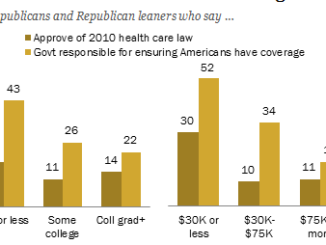
Downloads
Background
Means-tested welfare programs are intended to aid the poor. For the purposes of this brief, they include Medicaid, the Children’s Health Insurance Program (CHIP), the Supplemental Nutrition Assistance Program (SNAP), Temporary Assistance for Needy Families (cash assistance), and Supplemental Security Income (SSI). Eligibility for these programs and the value of the benefits are based on the immigration status of the recipient, the recipient’s income, the value of assets owned by the recipient, his or her employment status, specific state policies, and myriad other factors.
Temporary migrants are generally ineligible for welfare benefits.4 Lawful permanent residents must wait at least five years before they are eligible for means-tested welfare benefits, but states have the option of providing those benefits earlier from their own tax revenues.5 Illegal immigrants are ineligible for entitlement and means-tested welfare programs apart from emergency medical care.6 Naturalized citizens, U.S.-born children, refugees, and asylees are eligible for all entitlement and means-tested welfare programs.7 These rules have some exceptions: children of lawful permanent residents are eligible for SNAP benefits, and states can extend Medicaid benefits to children and pregnant women regardless of immigration status. Furthermore, in-kind benefits—such as the National School Lunch Program; the Special Supplemental Nutrition Program for Women, Infants, and Children (WIC); and Head Start—are available regardless of immigration status.
Entitlement programs are intended to aid the elderly, and they include Social Security retirement benefits and Medicare. The primary eligibility requirement for entitlements is the age of the recipient, but the value of taxes paid into those programs and the number of work years are factors in determining eligibility and the value of benefits.8 As such, lawful permanent residents who have paid payroll taxes for 40 quarters, or 10 years, are eligible to receive Social Security retirement benefits and Medicare.9
Methodology and Data
This brief exploits data from the Census Bureau’s 2017 Annual Social and Economic Supplement to the Current Population Survey (CPS), an annual survey of the civilian noninstitutionalized population of the United States that examines data from 2016, to analyze the use rates and dollar values of means-tested welfare and entitlement programs in that year. Accounting for some nuances of welfare program eligibility and quirks in the CPS data is necessary to understand our results.
Program eligibility and the value of benefits are based on either the household level or individual level, a concept known as the unit of assistance. Individuals are the unit of assistance for Medicaid, CHIP, SSI, Social Security retirement benefits, and Medicare. Thus, many U.S.-born children in immigrant families receive Medicaid or CHIP even though their noncitizen parents do not. The household is the unit of assistance for SNAP and cash assistance, but the value of benefits is reduced in households where some family members are ineligible noncitizens. For example, if a poor three-person family is composed of two temporary migrants and a U.S.-born child, only the child counts in computing the value of SNAP and cash assistance benefits. For benefits delivered at the household level, the CPS data do not allow us to discern the immigration status of the intended recipients for children who live in households containing both citizens and noncitizens. As such, we assume that these benefits are split evenly among all members of each household in order to determine the value of benefits per individual.
We selected the welfare programs analyzed in this brief based on the availability of survey data that estimate the cash value of the benefit per individual recipient. These welfare programs constitute the majority of federal transfer spending. Together, the seven programs analyzed account for over 85 percent of nonveteran federal spending on means-tested welfare and entitlement programs.10 However, we had to rely on data sources other than the 2017 CPS in two cases. First, the value of SNAP benefits is not included in the CPS’s initial release, so we used the 2016 CPS instead of the 2017 version. Second, the CPS does not include estimates of the value of Medicare and Medicaid benefits. In place of the 2017 CPS, we used the Medical Expenditure Panel Survey (MEPS) for 2015, the most recent year for which data are available.
We define natives or native-born Americans as those who are born in the United States, in its territories, or to citizen parents living abroad. Naturalized Americans are those born abroad who have since become naturalized U.S. citizens. Noncitizen immigrants are foreign-born people who are not citizens of the United States and who include green card holders, refugees, asylees, temporary migrants, guest workers, and illegal immigrants. Citizen children of citizen parents includes the children of both native-born Americans and naturalized immigrants. Citizen children of noncitizen parents are those who are born in the United States to foreign-born parents who have not naturalized. Noncitizen children have not naturalized.
The CPS is the most commonly used source of data for analyzing immigrant and native welfare use, and MEPS is the only survey that provides the estimated dollar value of medical programs. Like other self-reported surveys, CPS and MEPS are vulnerable to sampling error. In particular, respondents to these surveys underreport public benefit use. Estimates of the extent of underreporting across programs range between 10 percent in the case of Social Security retirement benefits and 40 percent for SNAP.11 A common method to adjust for underreporting is the Urban Institute’s TRIM3 model that, among other things, reconciles program use rates and the dollar value of benefits received to federal and state administrative data on expenditures.12 We ultimately decided against using the TRIM3 model for this brief because it is available only up through 2014, which would exclude the most recent CPS welfare data. An alternative survey data source, the Survey of Income and Program Participation (SIPP), is less subject to the underreporting of welfare use and benefit levels.13 However, we decided against SIPP because it has a less timely release schedule, the most recent release was for 2013 data, and the results from SIPP are close to those produced by the CPS. The relative difference between immigrant and native welfare use rates and the dollar value of benefits received is so similar in both the CPS and SIPP that our results would not change if we used the latter survey.14
Results
Figures 1 and 2 display the average welfare costs per person per program by nativity. We calculated these figures by multiplying the immigrant and native use rates by the value of benefits they consumed. Figure 1 compares all immigrants with all natives. The average value of welfare benefits per immigrant was about $3,718 in 2016, about 39 percent less than the $6,081 average value of welfare benefits per native. The average immigrant consumed $6 more in cash assistance, $7 more in SNAP benefits, and $98 more in Medicaid than the average native did. However, the average immigrant consumed $56 less in SSI, $610 less in Medicare, and $1,808 less in Social Security retirement benefits than the average native in 2016—more than compensating for their overconsumption of cash assistance, SNAP, and Medicaid.
Figure 1
Average per capita welfare cost by program and nativity, 2016

Source: Authors’ analysis of the 2017 Annual Social and Economic Supplement to the Current Population Survey and the 2015 Medical Expenditure Panel Survey data.
Figure 2
Average per capita welfare cost by program and nativity for age- and income-eligible recipients, 2016

Source: Authors’ analysis of the 2017 Annual Social and Economic Supplement to the Current Population Survey and the 2015 Medical Expenditure Panel Survey data.
Figure 2 shows the average welfare cost of natives and immigrants who meet the income or age requirements for these programs: recipients must have an income that is at least 200 percent of the poverty line or below for means-tested welfare benefits or age 65 years or older for the Social Security and Medicare entitlement programs. The poverty line threshold differs by state, but it is a general nationwide metric that approximates an apples-to-apples comparison of people who are the intended beneficiaries of means-tested welfare programs. On average, each immigrant who is broadly eligible for the welfare or entitlement programs costs $16,088 in 2016, about 27 percent less than the average native who costs $21,926. The average poor or elderly immigrant costs less than the average poor or elderly native for every means-tested and entitlement program.
Welfare Use Rates
Table 1 presents a more detailed breakdown of welfare use rates for natives, immigrants, naturalized citizens, and noncitizens for adults age 19 and older.15 Table 2 presents welfare use rates for children divided into five groups: (a) natives, (b) immigrants, (c) citizen children of citizen parents, (d) citizen children of noncitizen parents, and (e) noncitizen children.
Table 1
Welfare use rates by nativity and immigration status for adults age 19 and older at all poverty levels, 2016

Source: Authors’ analysis of the 2017 Annual Social and Economic Supplement to the Current Population Survey and the 2015 Medical Expenditure Panel Survey data.
Table 2
Welfare use rates by nativity and immigration status for children age 18 and younger at all poverty levels, 2016

Source: Authors’ analysis of the 2017 Annual Social and Economic Supplement to the Current Population Survey and the 2015 Medical Expenditure Panel Survey data.
Adult immigrant use rates are below those of native adults for SSI, Medicare, and Social Security (Table 1). However, immigrant adults are more likely to use SNAP and Medicaid than native-born adults and equally as likely to use cash assistance. Naturalized immigrants are more than three times more likely than noncitizen immigrants to use Medicare and Social Security but less likely to use cash assistance, SNAP, and Medicaid. Naturalized immigrants are more likely to use entitlements than noncitizens. Relative to natives, naturalized immigrants are less likely to consume Social Security and slightly more likely to consume Medicare.
Child immigrants have lower use rates than native-born children for cash assistance, SNAP, SSI, and Medicaid (Table 2). Citizen children of noncitizen parents have the highest use rates for cash assistance, SNAP, and Medicaid. The Social Security and Medicare entitlement programs are not included in Table 2 because children are not eligible for those programs.
Tables 3 and 4 show welfare use rates for recipients who are at or below 200 percent of the poverty line for means-tested welfare programs and those who are age 65 and older for the Social Security and Medicare entitlement programs. Poor immigrants are less likely than natives to use every welfare program with the exception of Medicaid, where they are 0.4 percent more likely to use it (Table 3). Naturalized immigrants use less welfare than natives for every program except SSI and Medicaid. Noncitizens use every welfare program less than natives do, often by wide margins.
Table 3
Welfare use rates by nativity and immigration status for adults age 19 and older, poverty and age adjusted, 2016

Source: Authors’ analysis of the 2017 Annual Social and Economic Supplement to the Current Population Survey and the 2015 Medical Expenditure Panel Survey data.
Note: Recipients are at 200% of poverty line and below for means-tested welfare programs and age 65 and older for entitlement programs.
Immigrant children are also less likely to use all meanstested welfare programs than native-born children (Table 4). Noncitizen children are the least likely to use Medicaid even though the 2009 Children’s Health Insurance Program Reauthorization Act gave states the power to extend Medicaid and CHIP coverage to all noncitizen children and pregnant women regardless of immigration status.16 As of 2014, 29 states expanded CHIP to some lawfully present immigrants who have been here for fewer than five years.17
Table 4
Welfare use rates by nativity and immigration status for children age 18 and younger, poverty adjusted, 2016

Source: Authors’ analysis of the 2017 Annual Social and Economic Supplement to the Current Population Survey and the 2015 Medical Expenditure Panel Survey data.
Note: Recipients are at 200% of poverty line and below for means-tested welfare programs and age 65 and above for entitlement programs.
The Value of Welfare Benefits
The value of welfare benefits that each recipient group consumes by program shows that immigrant adults, including those who are naturalized and who are noncitizens, consume a lower dollar value in every program except for cash assistance (Table 5). The values are unavailable in the CPS for naturalized immigrants and noncitizens for Medicaid and Medicare. MEPS does provide the dollar amount of benefits but not detailed immigration information beyond native or immigrant. The CPS does not provide that information, and MEPS does not provide more detailed immigration status than nativity. Immigrant children, citizen children of noncitizen parents, and noncitizen children consume a lower value of welfare benefits than natives do (Table 6). The only exception is that all immigrants consumed slightly more in SSI benefits than the citizen children of citizen parents did.
Table 5
Value of welfare benefits by nativity and immigration status for adults age 19 and older in all poverty levels, 2016

Source: Authors’ analysis of the 2017 Annual Social and Economic Supplement to the Current Population Survey and the 2015 Medical Expenditure Panel Survey data.
Note: n/a = not available.
Table 6
Value of welfare benefits by nativity and immigration status for children age 18 and younger at all poverty levels, 2016

Source: Authors’ analysis of the 2017 Annual Social and Economic Supplement to the Current Population Survey and the 2015 Medical Expenditure Panel Survey data.
Note: n/a = not available.
Tables 7 and 8 show the value of welfare benefits consumed by recipients who are at or below 200 percent of the poverty line for means-tested welfare programs and those who are age 65 and older for the entitlement programs. Poor immigrants, the naturalized, and noncitizens consume a lower value in welfare programs than natives do with the exception of cash assistance (Table 7). Immigrant children and noncitizen children consume fewer welfare benefits than natives, and the citizen children of citizen parents consume the most (Table 8).
Table 7
Value of welfare benefits by nativity and immigration status for adults age 19 and older, poverty and age adjusted, 2016

Source: Authors’ analysis of the 2017 Annual Social and Economic Supplement to the Current Population Survey and the 2015 Medical Expenditure Panel Survey data.
Note: Recipients are at 200% of poverty line and below for means-tested welfare programs and aged 65 and above for entitlement programs. n/a = not available.
Table 8
Value of welfare benefits by nativity and immigration status for children age 18 and younger, poverty adjusted, 2016

Source: Authors’ analysis of the 2017 Annual Social and Economic Supplement to the Current Population Survey and the 2015 Medical Expenditure Panel Survey data.
Note: Recipients are at 200% of poverty line and below for means-tested welfare programs and aged 65 and above for entitlement programs. n/a = not available.
Comparing Studies
Previous analyses by the Center for Immigration (CIS) come to contrary conclusions regarding the relative use of public benefits by immigrants and natives.18 The main reason for our differing findings is that CIS analyzes welfare use by entire households based on whether the head is an immigrant, whereas we examine individuals by immigration status. Focusing on persons is more accurate because households headed by immigrants often contain multiple native-born Americans, including spouses and children. Furthermore, the unit of assistance for the largest welfare programs of Medicaid, CHIP, SSI, Social Security retirement benefits, and Medicare is the individual, not the household. CIS’s focus on the household unit of assistance for all welfare programs—regardless of the actual unit of assistance used in apportioning benefits—inflates immigrant welfare use. Focusing on individuals, rather than on households, allows this brief to identify which particular subgroups, such as naturalized immigrants or noncitizens, are receiving public benefits, whereas CIS’s methods preclude that type of granular analysis.
Conclusion
Immigrant consumption of welfare benefits through means-tested or entitlement programs is a complex issue as myriad programs have different eligibility requirements that vary by state. All immigrants consume 39 percent fewer welfare benefits relative to all natives, largely because they are less likely to receive Social Security retirement benefits and Medicare. Immigrants consume 27 percent fewer benefits relative to natives with similar incomes and ages. Although this brief does not count some smaller, noncash antipoverty programs, they are unlikely to alter our results even if the data were available for their inclusion. This brief provides the most recent estimates of immigrant and native welfare use.
Notes:
This immigration research and policy brief is an updated and revised version of Leighton Ku and Brian Bruen, “Poor Immigrants Use Public Benefits at a Lower Rate than Poor Native-Born Citizens,” Cato Institute Economic Development Bulletin no. 17, March 4, 2013.
1. Karen Spar and Gene Falk, “Federal Benefits and Services for People with Low Income: Overview of Spending Trends, FY2008-FY2015,” Congressional Research Service no. R44574, July 29, 2016, pp. 4-5; “The Budget and Economic Outlook: 2017 to 2027,” Congressional Budget Office, January 2017.
2. Spar and Falk, “Federal Benefits and Services for People with Low Income”; “The Budget and Economic Outlook: 2017 to 2027.”
3. Randy Capps, Michael E. Fix, and Everett Henderson, “Trends in Immigrants’ Use of Public Assistance after Welfare Reform,” in Immigrants and Welfare: The Impact of Welfare Reform on America’s Newcomers, ed. Michael E. Fix (New York: Russell Sage Foundation, 2009), pp. 123-52; Leighton Ku, “Changes in Immigrants’ Use of Medicaid and Food Stamps: The Role of Eligibility and Other Factors,” in Fix, Immigrants and Welfare, 152-92.
4. Alison Siskin, “Noncitizen Eligibility for Federal Public Assistance: Policy Overview,” Congressional Research Service no. RL33809, December 12, 2016.
5. “Overview of Immigrants’ Eligibility for SNAP, TANF, Medicaid, and CHIP,” Office of the Assistant Secretary for Planning and Evaluation, U.S. Department of Health and Human Services, March 27, 2012, https://aspe.hhs.gov/basic-report/overview-immigrants-eligibility-snap-tanf-medicaid-and-chip.
6. The government makes payments to health care providers for emergency services that are rendered to illegal immigrants who are eligible for Medicaid. This procedure helps ensure that reimbursement is available to the emergency care providers. Emergency rooms are required to treat illegal immigrants like other patients regardless of insurance status under the Emergency Medical Treatment and Active Labor Act.
7. “Overview of Immigrants’ Eligibility.”
8. “Who is Eligible for Medicare?” Social Security Administration, www.hhs.gov/answers/medicare-and-medicaid/who-is-elibible-for-medicare/index.html.
9. Siskin, “Noncitizen Eligibility for Federal Public Assistance.”
10. Authors’ calculations based on Michael Tanner, “The American Welfare State: How We Spend Nearly $1 Trillion a Year Fighting Poverty—and Fail,” Cato Institute Policy Analysis no. 694, April 11, 2012.
11. Bruce D. Meyer, Wallace K. C. Mok, and James X. Sullivan, “The Under-Reporting of Transfers in Household Surveys: Its Nature and Consequences,” NBER Working Paper no. 15181, National Bureau of Economic Research, July 2009.
12. Sheila Zedlewski and Linda Giannarelli, “TRIM: A Tool for Social Policy Analysis,” Urban Institute Research Report, May 2015.
13. Meyer, Mok, and Sullivan, “The Under-Reporting of Transfers in Household Surveys.”
14. National Academies of Sciences, Engineering, and Medicine, The Economic and Fiscal Consequences of Immigration (Washington: National Academies Press, 2017), p. 362.
15. The CPS data indicate which individual adults report receiving cash assistance and SSI but do not reveal which children received those benefits; so we only know whether the children are members of households that received those benefits. Thus, some immigrant children may be in families getting cash assistance or SSI benefits even though they are not the intended beneficiaries.
16. “Overview of Immigrants’ Eligibility.”
17. Evelyne P. Baumrucker and Alison Mitchell, “State’s Children Health Insurance Program: An Overview,” no. R43627, Congressional Research Service, March 20, 2015, p. 4.
18. Steven Camarota, “Welfare Use by Immigrant and Native Households: An Analysis of Medicaid, Cash, Food, and Housing Programs,” Center for Immigration Studies Backgrounder, September 10, 2015.
Alex Nowrasteh is an immigration policy analyst at the Cato Institute’s Center for Global Liberty and Prosperity. Robert Orr is a research assistant at Cato focused on welfare policy.



